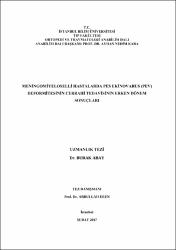| dc.contributor.advisor | Eren, Abdullah | |
| dc.contributor.author | Abay, Burak | |
| dc.date.accessioned | 2017-04-14T10:58:21Z | |
| dc.date.available | 2017-04-14T10:58:21Z | |
| dc.date.issued | 2017 | |
| dc.identifier.citation | Abay, Burak. MENİNGOMİYELOSELLİ HASTALARDA PES EKİNOVARUS (PEV) DEFORMİTESİNİN CERRAHİ TEDAVİSİNİN ERKEN DÖNEM SONUÇLARI.Yayımlanmamış doktora tezi. İstanbul : İstanbul Bilim Üniversitesi, Tıp Fakültesi. | en_US |
| dc.identifier.uri | https://hdl.handle.net/11446/1254 | en_US |
| dc.description.abstract | Pes ekinovarus deformitesi, spina bifidalı hastalarda en sık görülen ayak deformitesidir. Bu deformitenin tedavisi, idiyopatik pes ekinovarus tedavisinden daha rijid olması ve konservatif tedaviden sonra daha fazla nüks görülmesi yönüyle farklıdır. Bu retrospektif çalışmanın amacı, pes ekinovarus deformitesi olan spina bifidalı hastaların ayaklarının posteromedial gevşetme tekniği ile cerrahi tedavisinin sonucunda erken dönem fonksiyonel ve klinik sonuçlarını değerlendirmektir.
MATERYAL ve METOD
Bu çalışmaya, hikayesinde daha önceden başka merkezlerde konservatif tedavisi başarısız olan ve Ağustos 2014 - Kasım 2016 yılları arasında spina bifidalı 29 hastanın 39 pes ekinovarus deformiteli ayağı posteromediyal gevşetme tekniği ile kliniğimizde cerrahi tedavi edilenler dahil edildi. Hastaların ayakları lezyon seviyelerine göre gruplandırıldı. Ameliyat öncesi ayak deformiteleri Dimeglio sınıflaması ile skorlandı. Ameliyat öncesi ve sonrasında hastaların fonksiyonel kapasiteleri GMFCS (Gross Motor Function Classification System) ve FMS (Functional Mobility Scale) ile değerlendirildi ve sonuçlar karşılaştırıldı. BULGULAR
Ameliyat sonrası takip süresi ortalama 15,62 ay (2-27) idi. 29 hastanın 18’i erkek(%62,07), 11’i kadın(%37,93) olup, yaş ortalaması 5,45(2-13 aralığında) idi. 39 ayağın 21’i sağ ayak(%53,85), 18’i sol ayak(%46,15) idi. 29 hastanın 19’unda(%65,12) unilateral, 10’unda(%34,48) bilateral tutulum vardı. Sharrard sınıflamasına göre, ameliyat öncesi dönemde, 29 hastanın 39 ayağına(n=39) göre 4 torasik seviye(%10,26), 14 yüksek lomber seviye(%35,90), 16 alçak lomber seviye(%41,03), 5 sakral seviye(%12,82) olarak ayrıldı. Torasik grupta preop ve postop GMFCS ve FMS skorlarında anlamlı bir fark gözlenmedi.(p=1) Yüksek lomber, alçak lomber ve sakral lezyonu olanlarda preop ve postop GMFCS ve toplam FMS skorlarında istatistiksel olarak anlamlı bir sonuç gözlendi. (p<0,05) SONUÇ
Bu çalışmada, konservatif tedavi ile başarı sağlanamayan spina bifidalı hastalarda, pes ekinovarus deformitesinin cerrahi tedavisi ile erken dönemde hastaların fonksiyonel ve klinik sonuçlarında ilerleme gözlenmiştir | en_US |
| dc.description.abstract | INTRODUCTION
Pes equinovarus is the most common foot deformity in the patients with spina bifida. The treatment of the equinovarus deformity in these patients differs from the treatment of idiopathic clubfoot because of its rigidity and the high recurrence rate after the conservative treatment. The aim of this retrospective study is to evaluate the early functional and clinical results after the surgical treatment of the clubfoot in the spina bifida patients.
MATERIAL AND METHODS
Between August 2014 and November 2016, 39 feet with equinovarus deformity of the 29 spina bifida patients with the history of failed conservative treatment underwent surgical treatment with posteromedial release in our clinic. The feet are divided in groups on their neurological lesion. The preoperative and postoperative functional capacity of the patients were assessed with the GMFCS and FMS and the results were assessed. RESULTS
The avarage follow-up period was 15,62 months (2-27). 39 feet of 29 patients, 18 male (62,07%) and 11 female(37,93%), with the average age of 5,45(2-13) were included in this study. There were 21 right feet(53,85%) and 18 left feet(46,15%). 19 (%65,12) of 29 patients had unilateral deformity and 10 patients(34,48%) had bilateral deformity. The feet (n=39) of the 29 patients were divied to groups based on the Sharrard classification and the groups had 4 thoracic lesion(10,26%), 14 high lumbar lesion(35,90%), 16 low lumbar(41,03%) and 5 sacral lesion(12,82%). There was not statitistically significant change was obtained in the thoracic lesion group in the results of both preoperative and postoperative GMFCS and FMS scores.(p=1) There was statitistically significant improvement was obtained in the results of both postoperative GMFCS and FMS scores of the high lumbar, low lumbar and sacral groups. (p<0,05)
CONCLUSION
In this study, the improvements were observed in the functional and clinical results of the spina bifida patients after the surgical treatment of the pes equino varus deformity in the short term follow-up | en_US |
| dc.language.iso | tur | en_US |
| dc.publisher | İstanbul Bilim Üniversitesi, Tıp Fakültesi | en_US |
| dc.rights | info:eu-repo/semantics/openAccess | en_US |
| dc.subject | Spina bifida | en_US |
| dc.subject | pes ekinovarus | en_US |
| dc.subject | ayak deformitesi | en_US |
| dc.title | MENİNGOMİYELOSELLİ HASTALARDA PES EKİNOVARUS (PEV) DEFORMİTESİNİN CERRAHİ TEDAVİSİNİN ERKEN DÖNEM SONUÇLARI | en_US |
| dc.type | doctoralThesis | en_US |
| dc.department | DBÜ | en_US |
| dc.contributor.authorID | TR165485 | en_US |
| dc.relation.publicationcategory | Tez | en_US |


















